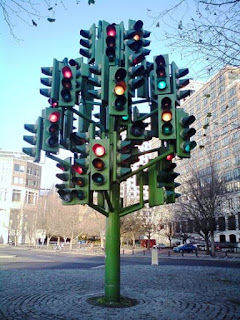Should smart cities be built on roundabouts?
My central philosophy for a smart city is to focus on vibrancy over occupancy by creating problems that encourage citizens to build their own solutions.
Roundabouts are amazing as they broadly have only one rule: give way to the right (for those of us who drive on the left). The rule is enhanced with best practices such as slow down on the approach, remain vigilant and aware, look twice, think bike and don’t block.
Traffic lights are awesome as they can learn and improve on the fly. There are many rules for delivering the light sequence delays as data from many other sensors affect and effect what is happening in real time to the traffic. Analysis, algorithms and new data can be all active in your frustration as to why the lights remain red when the road is clear – someone else knows better.
When considering these two incredible traffic control mechanisms you could apply the learning to risk, management, innovation, government, our own personal attitude, smart city thinking and probably a few more!
In the case of a roundabout, the individuals are given the common rule (give way) and asked to respect and follow it. Accidents happen when the rules are not followed and sometimes even when they are. There is no bigger feedback loop, no over-arching higher management and no one to crush change and innovation. Learning is based on the individual’s experience and improvements/adoption is passed slowly but can be very powerful such as FTFF (First There: First Forward). This allows the person who has waited the longest to go first in the case where everyone is unsure what to do. This isn’t a rule but a learned experience, and one that algorithms driving autonomous cars find hard to mimic.
In the case of traffic lights, someone else is on control – they set rules and determine best practice. The more lights in a centralised system control is better as all city lights can be controlled. In this case understanding complex rules is required, and that you yield control and learning to the person who writes and implements the algorithm. Your decision making has been taken away, your freedom has been taken away, you ability to influence the flow has been taken away – your actions are based on data and algorithms which you must follow – but it will be super efficient! Changes, innovations and learning can be rolled out instantly.
Roundabouts and traffic lights are both approaches that work for the management of traffic and in the majority of circumstances either technology will work most of the time. In a few cases both technologies can fail and result in gridlock where entrance into the system is greater than exists. In other circumstances only one of the technologies will deliver the desired result. Sometimes the community will respond, other times a centralised response is required. Occasionally we need the freedom to do nothing or both.
Given there is no right or wrong to either method or approach, how do we pick or swop solutions? Changing roundabout to traffic lights or vice versa requires a lot of planning and disruption. Changes in the solution in situ is uncommon, irrespective of whether it is functioning well.
In our own lives we tend to behave like this, favouring stability and sameness, disliking change even when a better solution is available.
A viewpoint could be that a smart city will pick vibrancy as the first solution, empowering and providing more freedom to the user to find the better solution.
So why should smart cities be build on roundabouts? My opinion it is that this solution enables users to influence the outcome, empowering smart citizens to find the most appropriate solution, which might be a centralised control system. For example, if we consider how our smart cities determine and respond to counter-terrorism. There is an implicit view that we need to make the right choices on technology and surveillance for what we see, understand and face today as a threat, and then change it when a new response is needed.
A roundabout theory approach to data collection and identity certainly works where the user is empowered, however, with today’s threat types there is also a need for a traffic light centralised command and control system to bring all the data together and determine the best course of action.
However, smart citizens need transparency on the data collection and algorithm to remove bias and prejudice.
Smart vibrant citizens, who are reading this, have already realised that roundabout and traffic lights are redundant in both old and new smart cities with the advent of self-driving autonomous vehicles, which will respond to all traffic situations by continually changing the speed and route, and so avoiding the traffic merging and control problems.
However, is this Uber-based utopian view a dictatorship-centrally controlled-traffic-lights-on-steroids solution, or a stress reducing enablement delivering far more time for art, culture, smartness and vibrancy?
